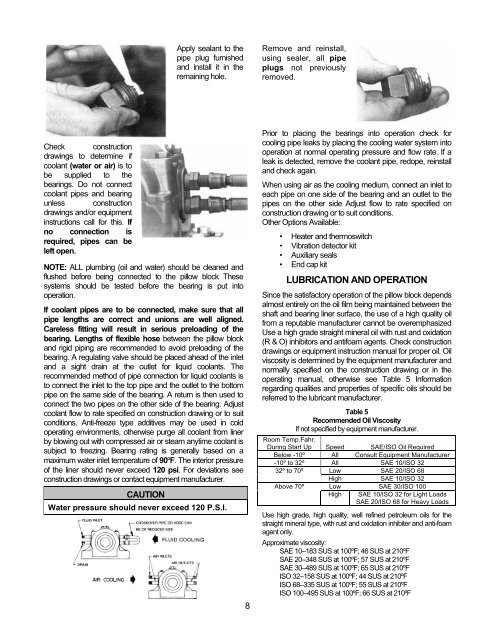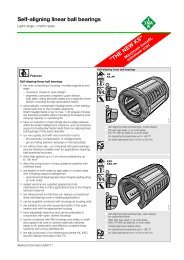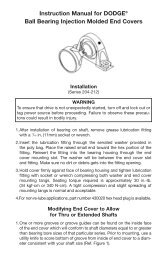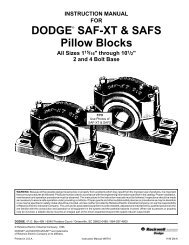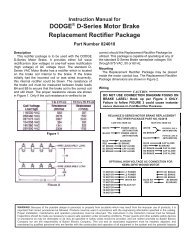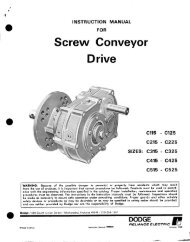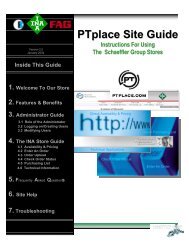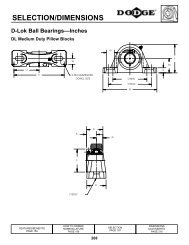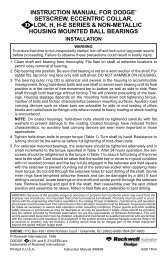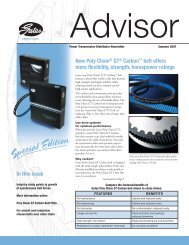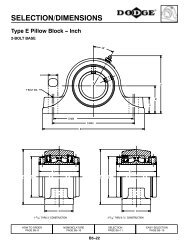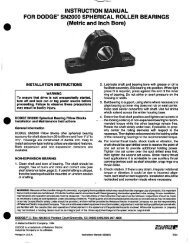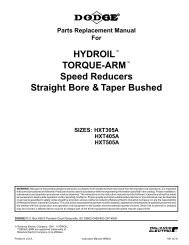DODGE SLEEVOIL RTL PILLOW BLOCKS - PTplace.com
DODGE SLEEVOIL RTL PILLOW BLOCKS - PTplace.com
DODGE SLEEVOIL RTL PILLOW BLOCKS - PTplace.com
You also want an ePaper? Increase the reach of your titles
YUMPU automatically turns print PDFs into web optimized ePapers that Google loves.
Apply sealant to thepipe plug furnishedand install it in theremaining hole.Remove and reinstall,using sealer, all pipeplugs not previouslyremoved.Check constructiondrawings to determine ifcoolant (water or air) is tobe supplied to thebearings. Do not connectcoolant pipes and bearingunless constructiondrawings and/or equipmentinstructions call for this. Ifno connection isrequired, pipes can beleft open.NOTE: ALL plumbing (oil and water) should be cleaned andflushed before being connected to the pillow block Thesesystems should be tested before the bearing is put intooperation.If coolant pipes are to be connected, make sure that allpipe lengths are correct and unions are well aligned.Careless fitting will result in serious preloading of thebearing. Lengths of flexible hose between the pillow blockand rigid piping are re<strong>com</strong>mended to avoid preloading of thebearing. A regulating valve should be placed ahead of the inletand a sight drain at the outlet for liquid coolants. There<strong>com</strong>mended method of pipe connection for liquid coolants isto connect the inlet to the top pipe and the outlet to the bottompipe on the same side of the bearing. A return is then used toconnect the two pipes on the other side of the bearing. Adjustcoolant flow to rate specified on construction drawing or to suitconditions. Anti-freeze type additives may be used in coldoperating environments, otherwise purge all coolant from linerby blowing out with <strong>com</strong>pressed air or steam anytime coolant issubject to freezing. Bearing rating is generally based on amaximum water inlet temperature of 90ºF. The interior pressureof the liner should never exceed 120 psi. For deviations seeconstruction drawings or contact equipment manufacturer.CAUTIONWater pressure should never exceed 120 P.S.I.8Prior to placing the bearings into operation check forcooling pipe leaks by placing the cooling water system intooperation at normal operating pressure and flow rate. If aleak is detected, remove the coolant pipe, redope, reinstalland check again.When using air as the cooling medium, connect an inlet toeach pipe on one side of the bearing and an outlet to thepipes on the other side Adjust flow to rate specified onconstruction drawing or to suit conditions.Other Options Available:• Heater and thermoswitch• Vibration detector kit• Auxiliary seals• End cap kitLUBRICATION AND OPERATIONSince the satisfactory operation of the pillow block dependsalmost entirely on the oil film being maintained between theshaft and bearing liner surface, the use of a high quality oilfrom a reputable manufacturer cannot be overemphasizedUse a high grade straight mineral oil with rust and oxidation(R & O) inhibitors and antifoam agents. Check constructiondrawings or equipment instruction manual for proper oil. Oilviscosity is determined by the equipment manufacturer andnormally specified on the construction drawing or in theoperating manual, otherwise see Table 5 Informationregarding qualities and properties of specific oils should bereferred to the lubricant manufacturer.Table 5Re<strong>com</strong>mended Oil ViscosityIf not specified by equipment manufacturer.Room Temp.Fahr.During Start Up Speed SAE/ISO Oil RequiredBelow -10º All Consult Equipment Manufacturer-10º to 32º All SAE 10/ISO 3232º to 70º Low SAE 20/ISO 68High SAE 10/ISO 32Above 70º Low SAE 30/ISO 100High SAE 10/ISO 32 for Light LoadsSAE 20/ISO 68 for Heavy LoadsUse high grade, high quality, well refined petroleum oils for thestraight mineral type, with rust and oxidation inhibiter and anti-foamagent only.Approximate viscosity:SAE 10–183 SUS at 100ºF; 46 SUS at 210ºFSAE 20–348 SUS at 100ºF; 57 SUS at 210ºFSAE 30–489 SUS at 100ºF; 65 SUS at 210ºFISO 32–158 SUS at 100ºF; 44 SUS at 210ºFISO 68–335 SUS at 100ºF; 55 SUS at 210ºFISO 100–495 SUS at 100ºF; 66 SUS at 210ºF


